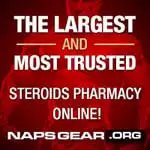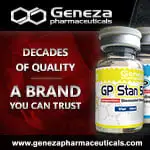Here are two (of many) articles available on Medline. They are both similar in that they report ventricular hypertrophy in both aas and non-aas strength athletes, but the aas-linked hypertrophy is greater. This effect persists, even after several years of abstinence from aas.
There is no evidence that cardiac function per se is affected, only that there is increased cardiac muscle mass in aas users.
Hope these help,
Tholdren
Source
Heart (British Cardiac Society). 90(5):496-501, 2004 May.
Abstract
OBJECTIVE: To investigate the reversibility of adverse cardiovascular effects after chronic abuse of anabolic androgenic steroids (AAS) in athletes. METHODS: Doppler echocardiography and cycle ergometry including measurements of blood pressure at rest and during exercise were undertaken in 32 bodybuilders or powerlifters, including 15 athletes who had not been taking AAS for at least 12 months (ex-users) and 17 currently abusing AAS (users), as well as in 15 anabolic-free weightlifters. RESULTS: Systolic blood pressure was higher in users (mean (SD) 140 (10) mm Hg) than in ex-users (130 (5) mm Hg) (p < 0.05) or weightlifters (125 (10) mm Hg; p < 0.001). Left ventricular muscle mass related to fat-free body mass and the ratio of mean left ventricular wall thickness to internal diameter were not significantly higher in users (3.32 (0.48) g/kg and 42.1 (4.4)%) than in ex-users (3.16 (0.53) g/kg and 40.3 (3.8)%), but were lower in weightlifters (2.43 (0.26) g/kg and 36.5 (4.0)%; p < 0.001). Left ventricular wall thickness related to fat-free body mass was also lower in weightlifters, but did not differ between users and ex-users. Left ventricular wall thickness was correlated with a point score estimating AAS abuse in users (r = 0.49, p < 0.05). In all groups, systolic left ventricular function was within the normal range. The maximum late transmitral Doppler flow velocity (Amax) was higher in users (61 (12) cm/s) and ex-users (60 (12) cm/s) than in weightlifters (50 (9) cm/s; p < 0.05 and p = 0.054). CONCLUSIONS: Several years after discontinuation of anabolic steroid abuse, strength athletes still show a slight concentric left ventricular hypertrophy in comparison with AAS-free strength athletes.
This next one demonstrates my point nicely, but they propose a mechanism for the hypertrophy:
Source
Cardiology. 90(2):145-8, 1998 Oct.
Abstract
Reports on the occurrence of left ventricular wall thickening in resistance-trained athletes have rejected the possibility for this physiological adaptation to occur without concomitant anabolic steroid abuse. Others have concluded short bursts of arterial hypertension that occur with maximal weight lifting are not sufficient to induce left ventricular wall thickening, and left ventricular wall thickness >/=13 mm should not be found in pure resistance-trained athletes. Therefore, we examined 4 elite resistance-trained athletes by two-dimensional echocardiography. In addition, we retrospectively examined the individual left ventricular dimensions of 13 bodybuilders from our previous echocardiographic studies. All 4 elite resistance-trained athletes had left ventricular wall thicknesses beyond 13 mm. One of the elite bodybuilders has the largest left ventricular wall thickness (16 mm) ever reported in a power athlete. Retrospectively, 43% of the drug-free bodybuilders and 100% of the steroid users had left ventricular wall thickness beyond the normal range of 11 mm. In addition, 1 drug-free subject and 3 steroid users were beyond the critical mark of 13 mm. No subjects demonstrated diastolic dysfunction. In contrast to previous reports, we have demonstrated that left ventricular wall thicknesses >/=13 mm can be found routinely in elite resistance-trained athletes. The use of anabolic steroids concomitant with intensive resistance exercise does appear to augment left ventricular size without dysfunction. Anabolic steroids may accelerate left ventricular wall thickening indirectly by increasing strength, thus augmenting the pressor response.
There is no evidence that cardiac function per se is affected, only that there is increased cardiac muscle mass in aas users.
Hope these help,
Tholdren
Source
Heart (British Cardiac Society). 90(5):496-501, 2004 May.
Abstract
OBJECTIVE: To investigate the reversibility of adverse cardiovascular effects after chronic abuse of anabolic androgenic steroids (AAS) in athletes. METHODS: Doppler echocardiography and cycle ergometry including measurements of blood pressure at rest and during exercise were undertaken in 32 bodybuilders or powerlifters, including 15 athletes who had not been taking AAS for at least 12 months (ex-users) and 17 currently abusing AAS (users), as well as in 15 anabolic-free weightlifters. RESULTS: Systolic blood pressure was higher in users (mean (SD) 140 (10) mm Hg) than in ex-users (130 (5) mm Hg) (p < 0.05) or weightlifters (125 (10) mm Hg; p < 0.001). Left ventricular muscle mass related to fat-free body mass and the ratio of mean left ventricular wall thickness to internal diameter were not significantly higher in users (3.32 (0.48) g/kg and 42.1 (4.4)%) than in ex-users (3.16 (0.53) g/kg and 40.3 (3.8)%), but were lower in weightlifters (2.43 (0.26) g/kg and 36.5 (4.0)%; p < 0.001). Left ventricular wall thickness related to fat-free body mass was also lower in weightlifters, but did not differ between users and ex-users. Left ventricular wall thickness was correlated with a point score estimating AAS abuse in users (r = 0.49, p < 0.05). In all groups, systolic left ventricular function was within the normal range. The maximum late transmitral Doppler flow velocity (Amax) was higher in users (61 (12) cm/s) and ex-users (60 (12) cm/s) than in weightlifters (50 (9) cm/s; p < 0.05 and p = 0.054). CONCLUSIONS: Several years after discontinuation of anabolic steroid abuse, strength athletes still show a slight concentric left ventricular hypertrophy in comparison with AAS-free strength athletes.
This next one demonstrates my point nicely, but they propose a mechanism for the hypertrophy:
Source
Cardiology. 90(2):145-8, 1998 Oct.
Abstract
Reports on the occurrence of left ventricular wall thickening in resistance-trained athletes have rejected the possibility for this physiological adaptation to occur without concomitant anabolic steroid abuse. Others have concluded short bursts of arterial hypertension that occur with maximal weight lifting are not sufficient to induce left ventricular wall thickening, and left ventricular wall thickness >/=13 mm should not be found in pure resistance-trained athletes. Therefore, we examined 4 elite resistance-trained athletes by two-dimensional echocardiography. In addition, we retrospectively examined the individual left ventricular dimensions of 13 bodybuilders from our previous echocardiographic studies. All 4 elite resistance-trained athletes had left ventricular wall thicknesses beyond 13 mm. One of the elite bodybuilders has the largest left ventricular wall thickness (16 mm) ever reported in a power athlete. Retrospectively, 43% of the drug-free bodybuilders and 100% of the steroid users had left ventricular wall thickness beyond the normal range of 11 mm. In addition, 1 drug-free subject and 3 steroid users were beyond the critical mark of 13 mm. No subjects demonstrated diastolic dysfunction. In contrast to previous reports, we have demonstrated that left ventricular wall thicknesses >/=13 mm can be found routinely in elite resistance-trained athletes. The use of anabolic steroids concomitant with intensive resistance exercise does appear to augment left ventricular size without dysfunction. Anabolic steroids may accelerate left ventricular wall thickening indirectly by increasing strength, thus augmenting the pressor response.


 Please Scroll Down to See Forums Below
Please Scroll Down to See Forums Below 











 DMI
DMI